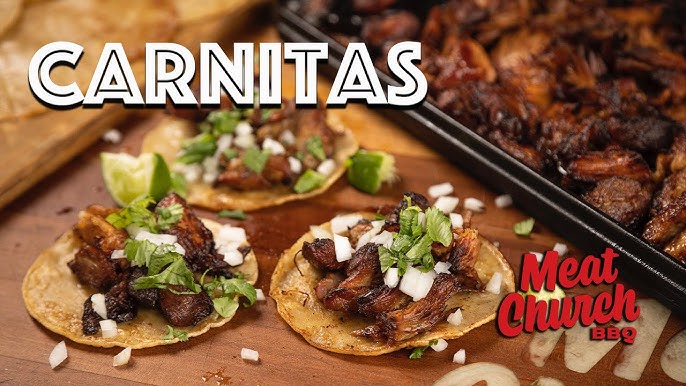Carnitas Recipe: Carnitas, a traditional Mexican dish, offers a flavor-packed experience with its juicy, tender pork and crispy, golden edges. Carnitas means “little meats” in Spanish, and it’s a dish famous for its versatility—it can be used in tacos, burritos, bowls, or as a delicious filling for sandwiches.
This step-by-step guide will walk you through creating authentic, restaurant-quality carnitas from the comfort of your kitchen.
What Are Carnitas?
Carnitas, originating from the Mexican state of Michoacán, are slow-cooked, seasoned pork that’s shredded and crisped to perfection. The result is succulent, fall-apart meat that has a slight crunch on the outside, perfect for building tacos, burritos, or any favorite Mexican-inspired dish. Carnitas are typically seasoned with spices like cumin, oregano, and a hint of citrus, providing a balanced taste that’s savory, aromatic, and a little tangy.
Key Ingredients for Carnitas
To make carnitas, you’ll need a few essential ingredients that provide depth and authentic flavor:
- Pork Shoulder or Pork Butt: The primary ingredient, providing a good fat-to-meat ratio.
- Onion and Garlic: These add aroma and flavor.
- Spices: Traditional carnitas recipes use cumin, oregano, salt, and pepper.
- Orange Juice and Lime Juice: For a hint of citrus that balances out the richness of the pork.
- Bay Leaves: These add a subtle earthiness.
- Lard or Oil: For searing and adding extra flavor.
Optional ingredients include cinnamon, chili powder, and jalapeños, depending on personal preference.
Choosing the Right Cut of Pork
For tender, melt-in-your-mouth carnitas, the best cuts of pork are pork shoulder or pork butt. These cuts have enough marbling and fat to stay juicy and flavorful after hours of cooking. The fat melts and tenderizes the meat, allowing it to fall apart easily after slow-cooking, which is essential for the authentic texture of carnitas.
Preparing the Ingredients
- Trim and Cut the Pork: Cut the pork shoulder or butt into large chunks, about 2-3 inches wide. This size ensures that the meat cooks evenly and remains tender.
- Seasoning the Meat: Generously season the pork with salt, pepper, cumin, and oregano. Rub the spices into the meat to ensure every piece is well-coated.
- Prepare Aromatics and Citrus: Peel and halve an onion, and smash several cloves of garlic. Juice one orange and one lime to add to the cooking liquid later.
Cooking Methods for Carnitas
The traditional way to cook carnitas is on the stovetop, but alternative methods like using a slow cooker or oven can also yield delicious results. Each method has its own advantages:
- Stovetop: Provides authentic flavor and texture with the control to sear, simmer, and crisp in one pot.
- Slow Cooker: A convenient, hands-off method that requires minimal monitoring.
- Oven: Ideal for large batches and can also achieve the crispy exterior without additional steps.
Step-by-Step Carnitas Recipe
Step 1: Seasoning the Pork
- In a bowl, combine 1 tablespoon of salt, 1 teaspoon of pepper, 2 teaspoons of cumin, and 1 teaspoon of oregano.
- Rub the seasoning all over the pork chunks, ensuring an even coating.
Step 2: Searing the Pork
- Heat 2-3 tablespoons of lard or oil in a large, heavy pot or Dutch oven over medium-high heat.
- Once hot, add the pork chunks in a single layer, browning them on all sides (about 2-3 minutes per side).
- Remove the seared pork and set it aside on a plate. This step locks in flavor and adds a nice base for the slow-cooking process.
Step 3: Slow-Cooking the Pork
- In the same pot, add onion halves, smashed garlic cloves, bay leaves, and any remaining seasoning mix.
- Pour in 1 cup of orange juice and 1/4 cup of lime juice. If the liquid doesn’t cover the pork, add a bit of water.
- Return the pork to the pot and bring the liquid to a simmer.
- Cover and reduce heat to low, allowing the pork to cook for 2-3 hours until fork-tender.
Step 4: Shredding the Pork
- Once the pork is tender, remove it from the pot and allow it to cool slightly.
- Using two forks, shred the pork into bite-sized pieces, discarding any excess fat.
- Save the cooking liquid, as it can be used later for added flavor during the crisping process.
Step 5: Crispy Carnitas Finish
- Heat a large skillet or cast-iron pan over high heat with a little oil or lard.
- Add the shredded pork in a single layer and pour a bit of the reserved cooking liquid over it.
- Allow the pork to crisp up, turning occasionally until it reaches the desired level of crispiness (about 5-8 minutes).
Serving Suggestions for Carnitas
Traditionally, carnitas are served with corn tortillas, a side of diced onions, fresh cilantro, and a squeeze of lime. However, they’re also perfect in burritos, quesadillas, rice bowls, or even over a fresh salad. Add toppings like avocado slices, salsa, or pickled jalapeños to enhance your carnitas dish.
Tips for Making the Best Carnitas
- Don’t Rush the Cooking: Slow-cooking allows the pork to break down into tender pieces. Rushing may result in tough meat.
- Season Generously: Carnitas rely on a rich blend of spices, so don’t skimp on seasoning.
- Crisp in Small Batches: To get that signature crispy texture, avoid overcrowding the pan during the final searing step.
Storing and Reheating Carnitas
Carnitas store well and make great leftovers. For the best storage:
- Refrigerate: Store in an airtight container for up to 3-4 days.
- Freeze: Place in a freezer-safe container for up to 3 months.
To reheat, add a little oil to a pan, re-crisp the pork, and add a bit of broth or cooking liquid for added moisture.
Tips for Perfect Carnitas Texture
Getting the right carnitas texture—juicy on the inside, crispy on the outside—is all about technique. Here’s how to perfect it:
- Cook Slowly for Tenderness: Low and slow cooking breaks down the collagen in the pork, resulting in tender, melt-in-your-mouth carnitas.
- Don’t Skimp on Fat: A little fat keeps the meat juicy and adds flavor.
- Crisping at the End: Whether on the stove or in the oven, a final crisping step creates that iconic texture.
How to Serve Carnitas
Carnitas is extremely versatile and can be enjoyed in various ways. Here are some ideas:
- Tacos: Serve carnitas in warm corn tortillas with toppings like chopped onions, cilantro, salsa, and a squeeze of lime.
- Burritos and Bowls: Use carnitas as a protein for burritos, rice bowls, or burrito bowls with guacamole, pico de gallo, and lettuce.
- Nachos and Quesadillas: Layer carnitas on tortilla chips with cheese and bake for carnitas nachos, or add to a quesadilla for a tasty snack.
Carnitas Tacos – The Perfect Assembly
Making carnitas tacos is simple but requires the right balance of ingredients for an authentic experience:
- Warm the Tortillas: Heat corn tortillas on a skillet until they’re soft and slightly charred.
- Add the Carnitas: Place a generous amount of shredded and crispy carnitas in each tortilla.
- Top with Fresh Garnishes: Add diced onions, cilantro, and fresh lime juice. For extra flavor, consider toppings like salsa, avocado, or pickled jalapeños.
Storing and Reheating Carnitas
Carnitas stores well, making it a great choice for meal prep.
Storing Leftovers
- Refrigerate: Store leftover carnitas in an airtight container in the fridge for up to 4 days.
- Freeze: Carnitas freezes well for up to 3 months. Divide into portions before freezing to make it easy to reheat only what you need.
Reheating Tips
- Stovetop: Reheat carnitas in a skillet with a bit of oil to regain their crispiness.
- Oven: Spread the meat on a baking sheet and warm at 350°F until heated through, then broil for a few minutes to re-crisp.
Common Variations of Carnitas
Experiment with these flavor variations to put a personal twist on the classic carnitas recipe:
- Citrus Carnitas: Add extra orange and lime juice for a refreshing, tangy flavor.
- Chipotle Carnitas: Mix in chipotle peppers for a smoky, spicy kick.
- Pineapple Carnitas: Add pineapple juice for a hint of sweetness, balancing the savory flavors.
Nutritional Information and Serving Sizes
Carnitas can vary in nutrition depending on preparation. Here’s a general overview:
- Calories: A typical serving (3-4 ounces) of carnitas contains around 200-300 calories.
- Protein: Each serving offers 20-25 grams of protein.
- Fat: Carnitas are high in fat, particularly if cooked with lard or oil, so adjust your portion size as needed.
Troubleshooting Carnitas
If you run into issues, here’s how to troubleshoot common carnitas mistakes:
- Too Dry: Ensure enough fat is used during cooking, and don’t cook at too high a temperature.
- Not Crispy Enough: Increase the broiling or stovetop crisping time, but watch closely to avoid burning.
- Overcooked: Shred the pork gently and add a bit of broth to restore moisture if it’s overcooked.
FAQs about Carnitas Recipe
1. Can I use another cut of pork for carnitas?
Yes, but cuts like pork loin or tenderloin might be leaner, resulting in less tender carnitas. Pork shoulder or butt is recommended for the best flavor.
2. What’s the best way to make carnitas crispy?
Use a hot skillet with a bit of oil and spread the pork out in a single layer. Adding a bit of cooking liquid also helps with flavor and crispiness.
3. Can I make carnitas in advance?
Absolutely! Carnitas can be stored in the fridge or freezer. Just reheat and crisp them up right before serving.
4. Can I make this recipe in an Instant Pot?
Yes, you can pressure cook the pork on high for about 30 minutes, then release pressure and crisp it in a skillet.
5. Are there vegan alternatives to carnitas?
Jackfruit or mushrooms can be cooked with similar seasonings to mimic carnitas. The texture will be different, but it offers a similar flavor profile for plant-based diets.
Conclusion
Making authentic carnitas at home is a rewarding way to bring the taste of Mexico into your kitchen. With tender meat and perfectly crispy edges, these carnitas are bound to become a favorite in your meal rotation. By following the steps and tips outlined here, you’ll achieve mouthwatering results every time. Now, gather your ingredients, fire up the stove, and get ready to enjoy the perfect carnitas!
References
For those interested in deepening their understanding of carnitas and enhancing their cooking techniques, here are some reputable sources that provide valuable insights and variations of the classic carnitas recipe:
- Serious Eats: Known for its thorough and scientific approach to cooking, Serious Eats offers a comprehensive guide on making authentic carnitas, with tips on achieving the perfect texture and flavor.
- Bon Appétit: This culinary magazine shares a unique spin on carnitas, including suggestions for accompaniments and serving ideas that enhance the overall dining experience.
- The New York Times Cooking: Featuring a classic take on carnitas, NYT Cooking’s recipe provides detailed instructions and helpful notes for beginners and seasoned cooks alike.
- Food Network: The Food Network’s carnitas recipe comes with step-by-step guidance and video links, making it a great resource for visual learners.
- Mexico in my Kitchen: A blog dedicated to authentic Mexican cuisine, Mexico in my Kitchen brings a traditional perspective to carnitas, complete with cultural insights and preparation tips from Mexican home cooks.
By consulting these sources, readers can explore different methods, gain expert tips, and find inspiration for crafting their own perfect carnitas at home.



